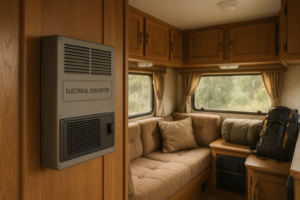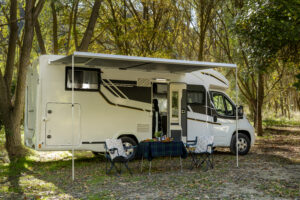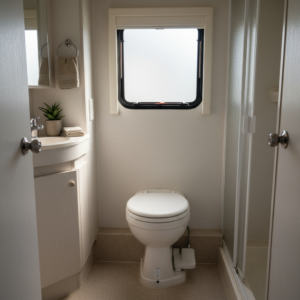How to Repair an RV Roof: A Complete Step-by-Step Guide for Campers & Travel Trailers
Table of Contents
A single overlooked crack in your recreational vehicle’s roof can lead to water damage, sometimes costing well over $5,000. Just one rainy night and a missed seam can leave you with a soggy mattress, water-stained walls, or worse. The good news? With the right tools and a little know-how—or help from our RV roof repair services—you can stop leaks and prevent further damage without breaking the bank.
This guide will walk you through how to repair your RV roof – whether rubber, fiberglass, metal, or hybrid. You’ll find step-by-step instructions, a complete tool checklist, and expert tips to fix it right the first time. This comprehensive guide is designed to be straightforward and actionable.
Remember, repairing your RV roof isn’t just about stopping leaky roof issues. It’s about protecting your home on wheels – keeping you safe and comfortable wherever the road takes you. Regularly scheduled RV roof maintenance is key to preserving your RV’s integrity and extending its lifespan.
RV Roof Types & Their Vulnerabilities
Every types of RV roof material has its strengths and quirks. Knowing what you’re working with is the first step to fixing it right.
1. Rubber Roofs (EPDM/TPO)
Rubber roofs are a go-to for many RV manufacturers thanks to their flexibility, lightweight build, and budget-friendly appeal. Typically made from either EPDM (Ethylene Propylene Diene Monomer) or TPO (Thermoplastic Olefin), they do a great job of insulating your RV and standing up to moderate weather.
But like any material, they need regular upkeep, and if you’re not keeping an eye on them, small issues can quickly turn into big (and expensive) problems. Here are the most common rubber roof vulnerabilities to watch out for:
- Tears from branches scraping against the rv roof.
- UV damage over time, especially in sunny states like Arizona or Florida.
- Seam separation, which allows water to sneak in.
Best Fixes:
- EternaBond or Tedlar tape: Great for small to medium tears or missing material up to about 18″ × 18″. While not ideal for seam repair, these tapes work well on new seams that need abrasion resistance, like slide room roof-to-fascia joints.
- Liquid rubber coatings: Typically used for full-roof overcoats, regardless of material, rather than spot fixes.
- Self-leveling and non-sag sealants: Best for sealing pinholes up to ¼”, as well as curb flanges around vents, skylights, and transition strips at the front or rear of the rv roof. This is a critical type of RV roof sealant.
2. Fiberglass Roofs
Fiberglass roofs are a favorite among RV owners who want something tough, long-lasting, and sleek. You’ll often find them on mid- to high-end motorhomes and travel trailers because of their rigid structure and smooth, polished finish. Plus, fiberglass is great at resisting dents, mildew, and general wear from the road.
That said, fiberglass isn’t immune to the elements or age. If you’ve had your RV for a few seasons or bought it used, you might already be seeing signs of damage setting in. Here are the common issues you need to keep an eye on:
- Gelcoat cracks due to aging or impact.
- Delamination, where the fiberglass separates from its underlayer.
- Osmotic blisters, which form from trapped moisture beneath the surface.
Best Fixes:
- Marine-grade epoxy: For strong, structural repairs.
- UV-resistant gelcoat: To reseal and protect the surface.
3. Metal Roofs (Aluminium/Steel)
You’ll often find metal roofs, typically aluminium or galvanised steel, on older RVs, classic Airstreams, and many vintage trailers. Their appeal? Old-school toughness. These roofs are built like tanks, offering serious durability and a timeless look that many RVers still love. They don’t degrade under UV rays the way rubber roofs do, and they hold up well under snow loads or rough road conditions.
But even metal has its weak points, especially as time and weather take their toll. The seams, fasteners, and panels can wear down over time, leading to roof leaks or structural issues. Unlike rubber or fiberglass roofs that may visibly bubble or crack, metal rv roof issues often go unnoticed until it’s too late, and by then, water may have already seeped into your sub-roof or insulation. You need to watch out for:
- Corrosion around the seams.
- Cracks or loosened fasteners caused by thermal expansion.
- Punctures from falling debris that can cause hidden leaks.
Best Fixes:
- Rust inhibitors like Rust-Oleum Rust Reformer.
- Seam-sealing tape such as Eternabond or Tedlar is ideal for durable, flexible patching. While the term “butyl tape” often refers to the secondary sealant used under curb flanges for vents, skylights, and doors, these brands offer seam-specific tapes designed for surface repairs. They come in various finishes and sizes, including rubber or aluminum top layers to match the existing rv roof.
- Aluminum polish and protectant to restore shine and guard against oxidation on metal surfaces.
4. TPO (Thermoplastic Roofing Systems) and PVC Roofs
Many newer, high-end motorhomes and fifth wheels come equipped with advanced thermoplastic roofing systems, such as PVC (polyvinyl chloride) or TPO (thermoplastic polyolefin). While sometimes casually called “hybrids,” these two materials are distinct yet similar in performance. Both are engineered for long life, minimal upkeep, and excellent weather resistance – making them popular among full-timers and frequent travelers.
PVC roofs like XTRM-PVC are known for their toughness, UV resistance, and reduced risk of chalking or cracking. TPO shares many of these benefits but uses a slightly different chemical composition. Both systems use a single-ply membrane that resists mold, mildew, and weather damage. Their seams are typically heat-welded, not glued, forming a watertight and durable bond.
An added bonus: PVC and TPO surfaces can reflect up to 100 times more UV light than traditional roofing materials, helping keep the RV interior cooler. However, their static charge tends to attract dust, which can darken the surface and reduce reflectivity – regular washing is key.
Despite their durability, issues can still arise if not properly maintained, such as:
- Scratches from low-hanging branches.
- Adhesion issues, especially if incompatible sealants were used in past repairs.
- Shrinkage or membrane pull-back in extreme temperature condition
- Damage from roof-mounted accessories such as satellite dishes, solar panels, bike racks, or roof ladders
Best Fixes:
- PVC- or TPO specific adhesives.
- Heat-welded patches for a permanent seal.
Tools & Materials Checklist
Before you climb onto your RV’s roof, make sure it’s rated as walkable. Not all RV roofs are designed to support weight, and stepping on a non-walkable surface can lead to damage or injury. If your roof isn’t walkable, these repair and maintenance tasks may need to be done from a ladder or gantry instead.
Once confirmed, gather the right tools to make the job safer and more efficient. Here’s what you should have on hand:
Universal Tools
- FLIR: Ideal for spotting hidden leaks by detecting cool, moisture-laden areas beneath the surface, where water might be trapped.
- Safety Harness and OSHA-Compliant Ladder or Rolling Staircase: Your first line of defense against falls. Avoid leaning extension ladders against RV sidewalls or rain gutters, as this can cause damage.
- Oscillating Tool: Offers precise control for removing old, hardened sealants without damaging the underlying rv roof material.
- UV Flashlight: Helps detect seam cracks, especially on rubber roofs or sealant-covered areas.
- Painter’s Tape: Helps create clean edges when applying coatings or sealants, making repairs look neat and professional.
Material-Specific Repair Kits
Rubber Roofs
- EternaBond Tape: Creates a strong, flexible seal over tears or seams and holds up well even in extreme temperatures.
- Dicor Self-Leveling Lap Sealant: Flows smoothly into cracks and around fixtures, sealing edges with a weatherproof, flexible finish. This is a common RV roof sealant.
- Dicor Non-Sag Lap Sealant: Ideal for vertical or uneven surfaces where flow control is needed to prevent running.
- Liquid Rubber Roof Coating: Adds a seamless protective layer that restores UV resistance and extends rv roof life.
- Rubber Roof Primer: Often recommended before applying liquid rubber, especially on older roofs, for better adhesion.
Fiberglass Roofs
- MarineTex Epoxy: A heavy-duty filler that bonds well to fiberglass and hardens like rock, perfect for patching structural cracks.
- Interlux Brightside Polyurethane Topcoat: Provides a glossy, durable finish that resists UV rays and harsh weather, restoring the rv roof’s original look.
- Fiberglass Repair Cloth: Useful for reinforcing epoxy patches in larger cracks or weak spots.
- Acetone or Fiberglass Surface Cleaner: Important for prepping the surface before bonding or coating.
Metal Roofs
- Rust-Oleum Rust Reformer: Chemically converts rust into a paintable surface, stopping corrosion before it spreads.
- Geocel 2310L Sealant: Stays flexible over time and adheres exceptionally well to metal, making it great for sealing seams and flashing areas.
- Wire Brush or Drill-Mounted Brush Head: Speeds up rust removal before applying the rust reformer.
- Polisher/Buffer: Essential for maintaining aluminium roofs like those on Airstreams; helps shine the surface and prevent oxidation.
- Metal Roof Patch (Aluminium Roll or Flashing Tape): For reinforcing large punctures or seams before sealing.
Hybrid/PVC Roofs
- PVC Roof Cleaner (Like XTRM Clean): Prepares the surface to ensure proper adhesion by removing dirt and oils.
- PVC-Compatible Adhesive or Sealant: Prevents bonding issues; use only products designed for PVC membranes like XTRM Universal Sealant.
- Heat Gun or Hot-Air Welder (for Advanced Users): Required for heat-welded patches on certain PVC roofing systems.
Step-by-Step Repair Guide
Now, let’s walk through exactly how to repair an RV roof, depending on the different types of roof material and the kind of damage you’re dealing with.
1. Pre-Repair Inspection
Start by identifying and assessing the problem before making any repairs:
- Infrared Scan: Use a thermal camera to detect moisture. This helps spot leaks that often show up as cooler areas beneath the surface.
- Chalk Test: Run water over the rv roof while another person checks inside for leaks. Use chalk to mark water entry paths and get a clear picture of where the leaks are coming from.
2. Safety First
- Follow OSHA Guidelines: If your rv roof is over six feet off the ground, wear a fall arrest system. Caution is always advised.
- Check the Weather Forecast: Avoid working in rain or temperatures below 50°F. Most sealants won’t cure properly in cold or damp conditions. Also ensure the work area is protected from the morning or evening dew.
3. Material-Specific Repairs
Let’s get into the nitty-gritty, one roof type at a time. For small repairs, you can often manage this yourself.
Rubber Roofs
- Clean the damaged area with EternaClean Spray or a rubber roof cleaner.
- Cut a piece of EternaBond tape slightly larger than the damaged section.
- Press the tape firmly in place, then smooth it with a roller to remove air bubbles.
- Apply liquid rubber coating over the patch, extending at least 6 inches beyond the repair area.
Fiberglass Roofs
- Use a sander to remove the damaged gelcoat or blister.
- Fill the area with MarineTex epoxy, shaping it with a putty knife.
- Let it cure fully (typically overnight), then sand it smooth.
- Apply a coat of Interlux Brightside polyurethane to reseal.
Metal Roofs
- Use a wire brush or grinder to remove rust.
- Apply Rust-Oleum Rust Reformer to neutralize any remaining corrosion.
- Seal seams with Geocel 2310L for lasting flexibility.
- For punctures, install a metal patch over the area and seal the edges thoroughly.
4. Post-Repair Validation
Don’t skip the final step! Double-check your work to ensure your repairs hold:
- Re-run the infrared scan to ensure all cool spots are gone.
- Perform another chalk test to verify no new leaks.
- Wait 48 hours before hitting the road to allow complete curing of sealants and coatings.
Preventive Maintenance: Keep Leaks from Coming Back
Want to avoid another round of rv roof repair? Make preventive maintenance part of your RV maintenance routine. Regular checks can stop small issues from becoming costly problems. This is essential to keep your roof in top condition and protect your exterior.
Monthly Checklist:
- Use a UV Flashlight: Check for seam degradation or hairline cracks, especially on rubber roofs.
- Inspect Roof Seams and Seals: Look for any visible wear, gaps, or small tears that could let water in.
- Check for Standing Water: After rainfall, ensure there is no water pooling on the rv roof. Stagnant water can damage roof materials over time.
- Clean Roof Drainage: Clear out any debris around the roof drains, vents, or gutters to prevent clogs and keep your roof draining properly.
- Be Mindful of Storage Location: Avoid parking your RV under trees for long periods. The shade encourages moisture retention, which can lead to mold, mildew, and algae growth. Tree sap can also stain or damage the rv roof surface. If your RV is stored outside, this is particularly important.
Seasonal:
- Check for Debris: Leaves, branches, or dirt can cause abrasions or block drainage areas. Clear your rv roof of any debris to prevent potential damage or water retention.
- Inspect the Sealant: Look for any cracks or gaps in the rv roof’s sealant, especially after a change in seasons or extreme weather conditions. Reapply new sealant as needed to maintain a waterproof barrier. You may need to remove old sealant first.
- Check for Visible Damage: Inspect your RV roof surface for signs of damage like cracking, bubbling, or other issues caused by the weather.
- Wash and Condition: Wash your RV roof every three months at a minimum for best results. This also makes inspections far more effective.
- Apply a UV Protectant: Use a UV protectant with at least 86% reflectivity to help prevent UV damage and lower internal temperatures.
Annually:
- Book a Professional Inspection:A trained eye can spot early signs of damage before they escalate. This is a strong recommendation.
- Schedule General Maintenance: Consider Good Sam RV ProCare’s general maintenance and repair service package to refresh coatings, reseal seams, and test for leaks. We recommend doing this for your rv roof every least twice a year.
When to Repair vs. Replace
Deciding whether to repair an RV roof or replace your rv roof can be a tough call. Here’s how to know when a quick fix is enough and when a full replacement will save you more time, money, and frustration down the road. If you suspect significant damage, it’s crucial to act promptly.
Hybrid/PVC Roofs
- PVC Roof Cleaner (Like XTRM Clean): Prepares the surface to ensure proper adhesion by removing dirt and oils.
- PVC-Compatible Adhesive or Sealant: Prevents bonding issues; use only products designed for PVC membranes like XTRM Universal Sealant.
- Heat Gun or Hot-Air Welder (for Advanced Users): Required for heat-welded patches on certain PVC roofing systems.
Repair Your RV Roof If:
- Damage is less than 6 inches wide.
- There’s no structural rot underneath.
- Leaks are localized and not recurring.
Replace Your Roof If:
- More than 30% of the surface is delaminated.
- You feel soft spots when walking on the rv roof – this usually signals rot or water damage underneath.
- You find yourself patching the same area repeatedly without long-term success.
- Your rv roof needs to be repaired extensively and frequently.
Pro Tip:Take time stamped photos before, during, and after repairs. It makes insurance claim approval a lot smoother if you ever need it. For complex issues, always consult a professional. Don’t hesitate to seek professional repair if needed, rather than attempting a challenging DIY fix that could lead to further damage to your recreational vehicle.
Wherever Your RV Takes You, We’re There
At Good Sam RV ProCare, we share your love for the camper lifestyle and RV living. Need expert help with RV roof repair or other professional services near you? Give us a call at 833‑782‑2731, or reach out to learn more about the service locations we currently cover. We help you take your RV wherever you want, safely.
Protect Your RV Investment with Expert Roof Repair from RV ProCare
Taking care of your rv roof isn’t just about stopping leaks; it’s about preventing water damage and protecting your investment for the long haul. Whether you’re dealing with minor wear or major damage, staying on top of RV roof maintenance can save you from costly surprises down the road.
Not sure where to start or dealing with a tough repair? Let the pros handle it. Schedule RV roof repair or replacement with Good Sam RV ProCare and get peace of mind knowing your rig is road-ready and weather-tight. Book your appointment today and hit the road with confidence.
Frequently Asked Questions (FAQs)
Will DIY repairs void my RV warranty?
Not necessarily – it depends on your warranty terms. Some manufacturers require certified techs, but others allow self-repair as long as you follow approved methods and use compatible materials. Always check with your dealership or manufacturer for specific guidelines.
Can I walk on my RV roof after repairs?
If you’ve sealed the area properly and allowed 48 hours to cure, walking on the rv roof is fine. Just avoid stepping directly on freshly patched sections and wear non-slip, soft-soled shoes to prevent damage or sealant disruption. Treat it with the same care as you would any other part of your household.
How do I find mobile RV roof repair near me?
If a DIY fix isn’t in the cards, Good Sam RV ProCare offers mobile RV roof repair services near you across states. Get professional help without leaving your campsite.


